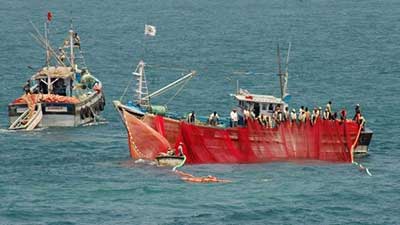Date: 18/02/2023
Relevance: GS-2: Conservation, Environmental Pollution, and Degradation, Environmental Impact Assessment.
Key Phrases: United Nations Convention on the Law of the Sea (UNCLOS), purse seine fishing, Convention for the Conservation of Southern Bluefin Tuna 1993, non-selective fishing technology, The Tragedy of the Commons, Exclusive Economic Zone.
Why in News?
- The Supreme Court of India has given permission to fishermen using purse seine fishing gear to fish beyond territorial waters (12 nautical miles) and within the Exclusive Economic Zone (EEZ) (200 nautical miles) of Tamil Nadu, but observing certain restrictions.
What is the issue?
- The Court’s interim order, against the banning of purse seine fishing by the Tamil Nadu Government, seems to be more concerned about regulating fishing with administrative and transparency measures than about the conservation measures and obligations which a coastal state owes in its EEZ under the United Nations Convention on the Law of the Sea (UNCLOS).
- Conservation measures (as suggested in various regional conventions) and judgments of various tribunals (embodying conservation measures based on best science or relevant scientific evidence to control overfishing and protect endangered marine living resources from extinction) should have informed the order.
- Purse seiners tend to overfish, unlike traditional fishermen using traditional fish gear, thus endangering the livelihood of the traditional fisher.
What is purse seine fishing?
- A purse seine is a large wall of netting deployed around an entire area or school of fish.
- The seine floats along the top line with a lead line threaded through rings along the bottom.
- Once a school of fish is located, a skiff encircles the school with the net. The lead line is then pulled in, "pursing" the net closed on the bottom, preventing fish from escaping by swimming downward.

Conservation and conventions:
- The top court should seek guidance from the obligations arising from the multilateral and regional conventions which are meant to bring in sustainable fishing practices over a certain period of time, thereby allowing a common resource such as fish to be naturally replenished.
- UNCLOS:
- Under Articles 56.1(a) and 56.1(b)(iii) of UNCLOS, coastal states have sovereign rights to ensure that the living and non-living resources of the EEZ are used, conserved, and managed, and not subject to overexploitation.
- Access to the zone by foreign fleets is also solely within the coastal state’s discretion and subject to its laws and regulations.
- To prevent overexploitation, coastal States must determine the total allowable catch (TAC) in the EEZ in light of the best scientific evidence available.
- Convention for the Conservation of Southern Bluefin Tuna 1993 (SBT):
- It is another source of guidance that could have been utilized by the Court to enable the recovery of depleted fishing stocks.
- The crux of the SBT is TAC and distribution of allocations among the parties to the SBT, which are very relevant from the angle of conservation of general fishery.
- Maintaining maximum sustainable yield:
- TAC and the catch quotas are aimed at putting sustainable use into practice among fishermen and maintaining maximum sustainable yield (MSY).
- The efforts to implement TAC and catch quota might face scientific uncertainty relating to safe limits to ensure MSY.
- In such a situation, the established international environmental law practice is to lean on adopting a precautionary approach.
Regulation of fishing methods
- Restricting purse seine fishermen to fish on specific days and hours is not enough to regulate their fishing methods.
- International legal efforts are moving in the direction of abandoning the use of large-scale pelagic nets.
- The huge size of purse seine nets allows maximum catch for the purse seiners, leaving behind insufficient catch for traditional fishermen.
- Several regional organizations prohibit the use of large drift nets or call for their prohibition, such as the 1989 Tarawa Declaration of the South Pacific Forum.
- The 1989 Convention for the Prohibition of Fishing with Long Drift Nets in the South Pacific restricts port access for drift net fishing vessels.
- Although these conventions and UN General Assembly resolutions are applicable to state parties on the high seas, they are relevant in preventing overfishing in general and conserving fishery management in the EEZ.
On non-selective fishing technology
- The Court must also consider non-selective fishing methods that result in the by-catch of other marine living species, including endangered species.
- A party under Article XX (b) of the UN resolution can take measures to protect human, animal, or plant life provided it involves “conservation of exhaustible natural resources if such measures are made effective in conjunction with restrictions on domestic production or consumption” (Article XX(g).
- In Shrimp/Turtle, the appellate body held that the U.S. measure — which prohibited imports of shrimp from any country that did not have a turtle-excluder fishing gear comparable to that of the United States — fit the Article XX(g) exception for the conservation of exhaustible natural resources.
Conclusion:
- Despite the best conservation measures and regulations, dealing with the limitless character of the seas poses a challenge, rendering a common resource such as fish available for exploitation by all.
- The theory of Garrett Hardin, “The Tragedy of the Commons,” says that “freedom in commons brings ruin to all,” and should convince all fishermen, especially purse seiners in Tamil Nadu, to cooperate in complying with conservation measures.
- The court must also consider the guidance of multilateral and regional conventions on sustainable fishing practices, regulating fishing methods, and non-selective fishing technology.
- Only by adopting a precautionary approach and cooperating in complying with conservation measures can we protect our marine resources for future generations.
Source: The Hindu
Mains Question:
Q. How can the conservation and sustainable management of fishery resources be achieved, while considering the challenges posed by non-selective fishing technology and the need for regulating fishing methods, and what role can multilateral and regional conventions play in this regard?






















